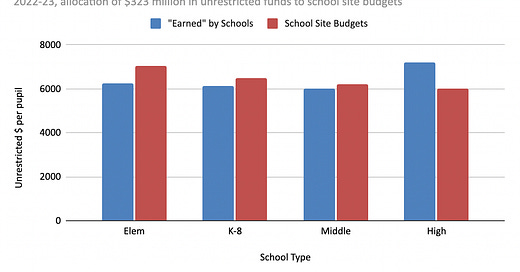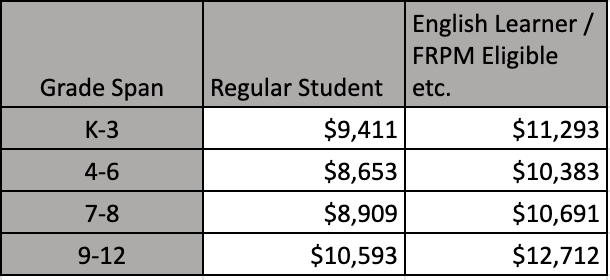SFUSD is starving its high schools
How SFUSD's funding formula takes money from high schools and uses it on elementary schools
School Funding Varies By Grade
By far the biggest component of SFUSD’s funding is the state’s Local Control Funding Formula (LCFF). The LCFF is based on attendance and attendance depends on enrollment. Every student effectively comes with a bagful of money representing the funding provided by government for the education of that student.
The LCFF has three components:
a base grant, received for all students
a supplemental grant, based on the Unduplicated Pupil Percentage (UPP) of kids who are FRPM-eligible (i.e. eligible for free or reduced-price meals) or English learners (or a couple of other high-needs categories). Every student in this category brings in an extra 20% in funding because such students are far more likely to require more intensive instruction and other assistance. The supplemental grant also compensates for the additional money that richer families are able to donate to their children’s schools.
a concentration grant, to districts where the UPP exceeds 55%, as it does in SFUSD.
The amount of money in the base grant is not the same for every student. Districts get more money for high school students than elementary school students because high schools need specialized teachers for every subject. And elementary school students bring in more money than middle school students because the state explicitly funds smaller class sizes for grades K-3.
School districts have the flexibility (the “local control” part of LCFF) to determine how best to spend the money they receive but they have a moral obligation to spend the money to the benefit of the children who bring it in. Money brought in to benefit high needs students should be spent on those high needs students. Money brought in to educate high school students should be spent on those high school students.
For 2022-23, the core LCFF funding (i.e. base plus supplemental grants) is expected to be:
If we make the simplifying assumption that each school’s enrollment is evenly divided across the grades it supports (e.g. a middle school has equal numbers of 6th, 7th, and 8th graders), we get the following values for each school type.
In other words, an FRPM-eligible high school student with perfect attendance brings in $12,712 in LCFF Base and Supplemental Grant money to the district while a regular middle school student with perfect attendance brings in only $8,823.
In percentage terms, SFUSD receives 16% more for a regular high school student with perfect attendance than it does for a regular elementary school student. Because the percentage of regular students varies from grade to grade, SFUSD’s actual expected revenue per high school student is 15%, not 16%, higher than for elementary school students.
It is not controversial to say that high schools are more expensive. High school students cost more to educate in the private sector too. Tuition for non-religious private high schools in San Francisco is over $50,000 annually while tuition for private K-8 schools is generally under $40,000. Tuition for Catholic high schools is around $25,000 while tuition at Catholic K-8 schools is closer to $10,000.
SFUSD’s Funding Approach
Some funding that SFUSD receives is passed directly to the schools that “earned” it. Title I funds from the federal government flow only to the schools that qualify for Title I. LCFF Concentration grant funds flow only to the schools whose UPP exceeds the threshold that qualifies the district to receive those funds. This is as it should be.
The LCFF Base and Supplemental grant money is not passed through in the same way. Some is used to fund the district office and all the centrally-provided services. A small amount is allocated to school budgets based on their numbers of special education students or English learners or low-income students.
For some individual schools, these dedicated or earmarked streams can be significant sources of money. At Ed Lee Newcomer school, they are worth $1970 per pupil compared to only $41 per pupil at Harvey Milk ES. While there may be significant school to school differences, the averages across school types are pretty close. On aggregate, elementary schools receive $637 per pupil from these dedicated or earmarked streams, middle schools $608 per pupil, high schools $513 per pupil, and K-8 schools $490 per pupil.
Most of the money spent at school sites (91% of all school site budgets on average) comes in the form of “unrestricted” funds. In the current 2022-23 budget, these unrestricted funds amount to $323 million.
This $323 million is allocated using an opaque Weighted Student Formula (WSF). If the weighted student formula were value-neutral, it would simply pass through to schools the money to which their enrollment entitles them after levying a tax to fund all the centrally-provided services. To the extent that the Weighted Student Formula produces results that are different from this value-neutral approach, this reflects the choices and preferences of the board and the district.
Suppose the $323 million were allocated to schools in proportion to how much funding the students at those schools brought in to the district. High schools would receive 15% more per student and middle schools 4% less per student than elementary schools. But that’s not what happens. In fact, high schools receive 15% less per student than elementary schools and middle schools 12% less.
In dollar terms, high schools are being shortchanged by almost $1200 per student.
SFUSD would probably argue that they’re using the money to meet their requirement to provide small class sizes in grades K-3. This argument shouldn’t fly. Other districts manage to meet their small K-3 class size requirements without cannibalizing their high school budgets. In fact, in many parts of the state, such as much of San Mateo County, the high school and elementary school districts are legally separate so they don’t have the option of robbing their high schools to fund their elementary schools.
Suppose that the Board agrees that high schools should receive 15% more funding than elementary schools but doesn’t want to cut the elementary school budgets. Suppose it proposes instead to devote any additional money that becomes available in future budget revisions to this priority. How much extra money would it take to rebalance the funding in this way? Forty million dollars, of which $ 33 million ($2100 per student) would go to high schools, $5 million ($580 per student) to middle schools, and $1.9 million ($440 per student) to K-8 schools.
Notice that I have said nothing about the allocation of money among the different high schools or among the different elementary schools. That’s a whole separate discussion that inevitably brings up emotional appeals to equity given the very different funding levels of the schools today. But every 1st grader will be an 11th grader in 10 years so every student is affected equally by SFUSD’s unbalanced funding.
Nor am I arguing specifically that the recently cut “AP Preparation” funding should be restored. The high schools were underfunded compared to the elementary schools before the AP money was eliminated. Now they are even more underfunded. It doesn’t matter whether the the justification for giving extra money to high schools is AP preparation or something silly like average student weight. All that counts is getting the high schools the funding they need.
Calculation Note
All the calculations here rely on the invaluable SFUSD site budget spreadsheet maintained by Tim Tahoe. Here’s Tim’s master spreadsheet and my copy showing the derivation of all the numbers and charts shown here.





